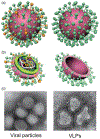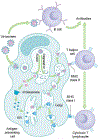Engineered Nanoparticle Applications for Recombinant Influenza Vaccines
- PMID: 32787280
- PMCID: PMC8011859
- DOI: 10.1021/acs.molpharmaceut.0c00383
Engineered Nanoparticle Applications for Recombinant Influenza Vaccines
Abstract
Influenza viruses cause seasonal epidemics and represent a pandemic risk. With current vaccine methods struggling to protect populations against emerging strains, there is a demand for a next-generation flu vaccine capable of providing broad protection. Recombinant biotechnology, combined with nanomedicine techniques, could address this demand by increasing immunogenicity and directing immune responses toward conserved antigenic targets on the virus. Various nanoparticle candidates have been tested for use in vaccines, including virus-like particles, protein and carbohydrate nanoconstructs, antigen-carrying lipid particles, and synthetic and inorganic particles modified for antigen presentation. These methods have yielded some promising results, including protection in animal models against antigenically distinct influenza strains, production of antibodies with broad reactivity, and activation of potent T cell responses. Based on the evidence of current research, it is feasible that the next generation of influenza vaccines will combine recombinant antigens with nanoparticle carriers.
Keywords: antigens; influenza; nanoparticles; particles; vaccine.
Figures









Similar articles
-
Structural basis for the development of avian virus capsids that display influenza virus proteins and induce protective immunity.J Virol. 2015 Mar;89(5):2563-74. doi: 10.1128/JVI.03025-14. Epub 2014 Dec 17. J Virol. 2015. PMID: 25520499 Free PMC article.
-
Influenza Neuraminidase Characteristics and Potential as a Vaccine Target.Front Immunol. 2021 Nov 16;12:786617. doi: 10.3389/fimmu.2021.786617. eCollection 2021. Front Immunol. 2021. PMID: 34868073 Free PMC article. Review.
-
Novel Platforms for the Development of a Universal Influenza Vaccine.Front Immunol. 2018 Mar 23;9:600. doi: 10.3389/fimmu.2018.00600. eCollection 2018. Front Immunol. 2018. PMID: 29628926 Free PMC article. Review.
-
[Universal influenza vaccines: developments, prospects for use].Vopr Virusol. 2012 Jan-Feb;57(1):9-14. Vopr Virusol. 2012. PMID: 22624467 Review. Russian.
-
Vaccination with Vesicular Stomatitis Virus-Vectored Chimeric Hemagglutinins Protects Mice against Divergent Influenza Virus Challenge Strains.J Virol. 2015 Dec 16;90(5):2544-50. doi: 10.1128/JVI.02598-15. J Virol. 2015. PMID: 26676789 Free PMC article.
Cited by
-
Adjuvanted nanoliposomes displaying six hemagglutinins and neuraminidases as an influenza virus vaccine.Cell Rep Med. 2024 Mar 19;5(3):101433. doi: 10.1016/j.xcrm.2024.101433. Epub 2024 Feb 23. Cell Rep Med. 2024. PMID: 38401547 Free PMC article.
-
Polycationic HA/CpG Nanoparticles Induce Cross-Protective Influenza Immunity in Mice.ACS Appl Mater Interfaces. 2022 Feb 9;14(5):6331-6342. doi: 10.1021/acsami.1c19192. Epub 2022 Jan 27. ACS Appl Mater Interfaces. 2022. PMID: 35084819 Free PMC article.
-
Engineered Nanoparticulate Vaccines to Combat Recurring and Pandemic Influenza Threats.Adv Nanobiomed Res. 2022 Mar;2(3):2100122. doi: 10.1002/anbr.202100122. Epub 2021 Dec 7. Adv Nanobiomed Res. 2022. PMID: 35754779 Free PMC article.
-
New insights for the development of efficient DNA vaccines.Microb Biotechnol. 2024 Nov;17(11):e70053. doi: 10.1111/1751-7915.70053. Microb Biotechnol. 2024. PMID: 39545748 Free PMC article. Review.
-
A liposome-displayed hemagglutinin vaccine platform protects mice and ferrets from heterologous influenza virus challenge.Proc Natl Acad Sci U S A. 2021 Jun 1;118(22):e2025759118. doi: 10.1073/pnas.2025759118. Proc Natl Acad Sci U S A. 2021. PMID: 34050027 Free PMC article.
References
-
- Center for Disease Control and Prevention 2019–2020 U.S. Flu Season: Preliminary Burden Estimates https://www.cdc.gov/flu/about/burden/preliminary-in-season-estimates.htm (retrieved June 2020),
-
- Hoffmann E; Krauss S; Perez D; Webby R; Webster RG Eight-plasmid system for rapid generation of influenza virus vaccines. Vaccine 2002, 20, (25), 3165–3170. - PubMed
Publication types
MeSH terms
Substances
Grants and funding
LinkOut - more resources
Full Text Sources
Medical

